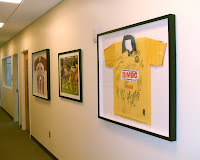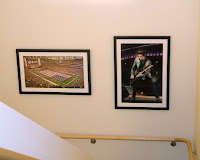Naked? Bueno! Naked walls? No bueno!
As you know we here at Mighty Imaging love BIG PRINTS. We love making photographs in to really large (huge) prints of astounding sharpness and clarity. With that in mind, we set about the mission of dressing up one of our favorite customers.
 Global Spectrum
Global Spectrum; a leader in sports, entertainment, and facility management, is in charge of operations for the award winning state of the art University of Phoenix stadium. Like many things in the Vally of the Sun, the stadium is brand spanking new. That means that Global's offices were nothing but naked walls. The first thing that we thought of was what a great place for large images. Just imagine how cool a bunch of big prints custom framed would look. Since everybody from the Arizona Cardinals of the NFL to the Rolling Stones have played there, how about tying it in to a theme of the company and the events that take place? Talk about inspiring interest!

Making a great first impression is always a good idea, and these exciting and vibrant event images make the office look fun and creative. Not only do our prints tell the Global Spectrum story to their customers, but it also creates a strong statement and fun work environment for their own people as well.
If your company's walls need to get dressed up here are a few ideas. First pick a theme, whatever you think will make the statement that you want. Not only will this unify the look of the images on the walls, but it will also unify the workplace. You could hire a photographer and have them find quirky abstract shots around the company plant or office. Then make huge prints that would attract attention by being familiar, yet not so easily recognized. Another idea is to collect a group of snapshots from the company picnic or holiday party and make a collage out of them. Your 30x40 lobby print can show that your company is proud of its employees and that you are a close team of workers.
Either way, the walls of your business should never be bare, so let's dare to dress them up!
 This is another reason to love Mozilla's web browser, Firefox. Their latest incarnation Firefox 3.0, which is now still in beta and will launch next year, has an exciting color profiling feature as one of their upgrades. The new version will read the color profile saved in your images and then take in to consideration the characteristics and settings of the monitor it is being viewed on to give a more accurate appearance. This is good news for many photographers out there.
This is another reason to love Mozilla's web browser, Firefox. Their latest incarnation Firefox 3.0, which is now still in beta and will launch next year, has an exciting color profiling feature as one of their upgrades. The new version will read the color profile saved in your images and then take in to consideration the characteristics and settings of the monitor it is being viewed on to give a more accurate appearance. This is good news for many photographers out there.







